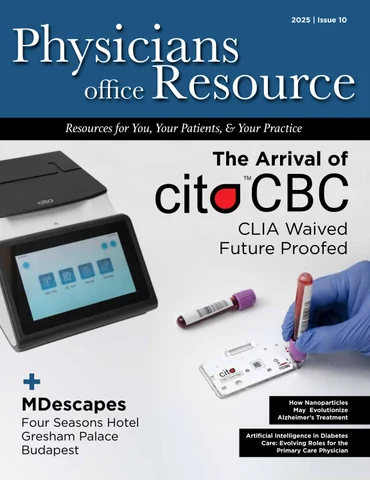The Crucial Role of Primary Care Physicians in Screening for Colorectal Cancer
Wednesday, March 26, 2025
by Adam Irving, Physicians Office Resource Staff Writer
Colorectal cancer (CRC) is the third most common cancer diagnosed in both men and women and remains a leading cause of cancer-related deaths worldwide. Early detection through screening significantly improves prognosis and reduces mortality. As primary care physicians (PCPs) play a crucial role in preventive medicine, understanding the available CRC screening options is essential for guiding patients in making informed choices. This article provides an overview of colorectal cancer, risk factors, and the various screening modalities available to detect the disease.
Epidemiology and Risk Factors
CRC primarily affects individuals over 50 years of age, but in recent years, there has been an increase in incidence among younger adults. Risk factors include:
- Age (50 years and older)
- Family history of colorectal cancer or adenomatous polyps
- Personal history of inflammatory bowel disease (ulcerative colitis, Crohn's disease)
- Genetic syndromes (e.g., Lynch syndrome, familial adenomatous polyposis)
- Lifestyle factors (diet high in red and processed meats, obesity, smoking, alcohol consumption, and physical inactivity)
Given these risk factors, PCPs should emphasize the importance of screening in at-risk populations and discuss modifiable lifestyle changes that may reduce CRC risk.
Screening Guidelines
The U.S. Preventive Services Task Force (USPSTF) and the American Cancer Society (ACS) recommend CRC screening for average-risk adults starting at age 45. Those with higher risk factors may need earlier and more frequent screening. Various screening methods exist, each with its benefits and limitations.
Screening Methods
There are two main categories of CRC screening tests: stool-based tests and visual (structural) exams. PCPs should be familiar with these options to help patients select the most appropriate test based on individual risk factors, preferences, and accessibility.
Stool-Based Tests
These non-invasive tests detect blood or DNA markers in stool samples and require no bowel preparation.
- Fecal Immunochemical Test (FIT)
- Detects hidden blood in the stool from lower gastrointestinal bleeding.
- Recommended annually.
- High sensitivity for detecting CRC but lower for adenomas.
- No dietary or medication restrictions.
- Guaiac-Based Fecal Occult Blood Test (gFOBT)
- Detects blood in the stool through a chemical reaction.
- Requires annual testing.
- Dietary restrictions (avoiding red meat and certain medications) are necessary.
- Lower sensitivity compared to FIT.
- Multi-Target Stool DNA Test (mt-sDNA) (e.g., Cologuard®)
- Detects both DNA mutations and occult blood.
- Recommended every three years.
- Higher sensitivity for CRC and advanced adenomas than FIT.
- More expensive than FIT and gFOBT.
Visual (Structural) Exams
These tests allow direct visualization of the colon and rectum and have higher sensitivity for detecting precancerous lesions.
- Colonoscopy
- Gold standard for CRC screening.
- Recommended every 10 years for average-risk individuals.
- Requires full bowel preparation.
- Allows for polyp removal and biopsy during the procedure.
- Higher cost and risk (perforation, bleeding) compared to non-invasive tests.
- Flexible Sigmoidoscopy
- Examines the rectum and lower third of the colon.
- Recommended every 5 years, or every 10 years when combined with FIT.
- Less invasive than colonoscopy but does not evaluate the entire colon.
- CT Colonography (Virtual Colonoscopy)
- Uses computed tomography to create detailed images of the colon.
- Recommended every 5 years.
- Requires bowel preparation but is less invasive than colonoscopy.
- Polyps detected require a follow-up colonoscopy for removal.
Choosing the Right Test for Patients
The best CRC screening test is the one that the patient is willing and able to complete. PCPs should discuss the pros and cons of each method while considering the patient’s risk factors, medical history, preferences, and access to healthcare facilities. Key considerations include:
- Average-Risk Individuals: FIT or colonoscopy are the most commonly recommended options.
- High-Risk Individuals: Colonoscopy is preferred due to its ability to detect and remove precancerous lesions.
- Patients Avoiding Invasive Tests: FIT or stool DNA testing may be suitable alternatives.
- Patients with Limited Access to Colonoscopy: Stool-based tests can be useful interim solutions.
Barriers to CRC Screening and Strategies to Improve Uptake
Despite the proven benefits of CRC screening, adherence remains suboptimal due to factors such as:
- Lack of awareness about screening recommendations.
- Fear or discomfort with colonoscopy preparation.
- Concerns over cost and insurance coverage.
- Limited access to healthcare providers or screening facilities.
To improve screening rates, PCPs can:
- Educate patients on the importance of CRC screening and available options.
- Offer multiple screening choices tailored to patient preferences.
- Implement reminder systems for patients due for screening.
- Advocate for policy changes that increase insurance coverage and access to CRC screening.
Primary care physicians play a pivotal role in colorectal cancer prevention and early detection. By understanding the different screening methods and individualizing recommendations based on patient preferences and risk factors, PCPs can help increase screening adherence and ultimately reduce CRC-related morbidity and mortality. Encouraging patients to participate in regular screening remains a key strategy in the fight against colorectal cancer.

